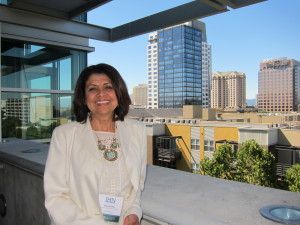By Sharon Simonson

DOWNTOWN SAN JOSE — If city governments nationwide don’t address the disconnect between their largely white, male chief executives and their increasingly racially and ethnically mixed populations, riots such as those in Ferguson, Mo., could become commonplace; even government overthrow is possible. That was the somber message Aug. 22 in San Jose from the president-elect of the country’s largest professional city management association.
Speaking before the 2014 California Regional Summit of the International Hispanic Network, Jim Bennett described himself as “a white guy from the whitest state, Maine.”
Like Silicon Valley’s technology companies — which have been pressed to release their workforce demographics and have largely conceded that they are mostly white and Asian males — city managers and municipal governments are going to find their organizations under scrutiny. “If we don’t change the dynamics in our city halls, our profession is going to be challenged,” Bennett said. “It is critical.”
Bennett begins his term as president of the International City/County Management Association this month. Washington, D.C.,-based ICMA has more than 8,000 members worldwide, mostly city and county managers and administrators appointed by local elected councils to run municipal governments.
The International Hispanic Network is a previously independent ICMA affiliate whose members seek to introduce city management as a professional choice to young Hispanics and to help Hispanics already involved in local government to progress.
Discussions of race and ethnicity discomfit some of his city manager colleagues. But over 30 years working in local government, he has seen little change in the ranks of top leadership, Bennett said. Only 13 percent of U.S. city managers are women, for instance, the same proportion as in the 1980s, he said.
Titled: “The Awakening of the Latino/Hispanic Population in the United States: Preparing for the Future,” the summit included keynote speaker Aida Hurtado. A Luis Leal Endowed professor and faculty member at the University of California, Santa Barbara, Hurtado described a demographic tsunami washing across U.S. shores, beginning in California and Texas. A published author, Hurtado has been retained by the Kellogg, Rockefeller and Ford foundations as a consultant on gender and education. She teaches in the Department of Chicana and Chicano Studies.

Fifty-three million U.S. residents today are of Hispanic origin, one in six of the nation’s population. Over the next four-and-a-half decades, the Census Bureau projects the proportion of U.S. Hispanics to rise to one in three. This fall, for the first time, Hispanic children will outnumber their non-Hispanic white peers nationwide in kindergarten through 12th grades. California reached the milestone in 2011, Hurtado said.
In 2060, the U.S. Census Bureau predicts that non-Hispanic whites will comprise 43 percent of the country’s population, down from 63 percent now. Asians will constitute 8.2 percent, and blacks, 15 percent.
“Here are the issues for you,” Hurtado said in the summit’s opening session: “This (Hispanic) population is going to have a central role in how this country grows, and we have almost no education as a group and very low income. That is where the problems lie.”
At not quite 500,000 people in the most current federal estimates, Hispanics constitute a quarter of the Santa Clara County population, the same proportion as in 2010. Most Silicon Valley and U.S. Hispanics are of Mexican origin.
The county’s Asian population, including people of Chinese, Indian, Vietnamese, Filipino, Japanese and Korean origin, totals more than 620,000.
“I think people come to this country and stay here because they like the way of life. I don’t think there is any ambivalence about that,” Hurtado said. “What we are struggling with is: how do we coexist and can we have a much more equitable society?”
In contrast to world events, where ethnic and racial strife characterize nearly every conflict, in the United States, “people aren’t killing each other as these demographic changes are occurring,” Hurtado said. “But they aren’t relating to each other, either.”
“How do we reconstitute society?” she asked.
She attributed the largely harmonious racial and ethnic relationships in the U.S. in part to social media’s ubiquity. “There is a kind of connectedness through a general and secular culture,” she said.
In the Bay Area’s Daly City — where more than half the population is foreign-born, 55 percent of residents are Asian and 25 percent are Hispanic — City Hall now navigates the rocky terrain between the cultures and traditions of native-born Americans and those of the newcomers, said Pat Martel, Daly City manager since 2005.
Among new immigrants, it’s common to want livestock at home and to have multiple generations of the same family living together, often crowded into an American-style single-family house. “It causes over-parking and garbage and a lot of issues that we have to deal with while being respectful,” she said. “We have to help communities understand that they have a responsibility to their neighborhoods not just their own families.”
A Hispanic woman, Martel has been elected Bennett’s successor as ICMA president. She spoke as a summit panelist on what working with diverse communities entails.
Demographic change is upon not only the Bay Area but also the nation, she said, and communities should embrace it and build on its benefits rather than focus on its costs. “The term ‘minority’ is no longer going to make any sense,” she said.
(Photos by Sharon Simonson)